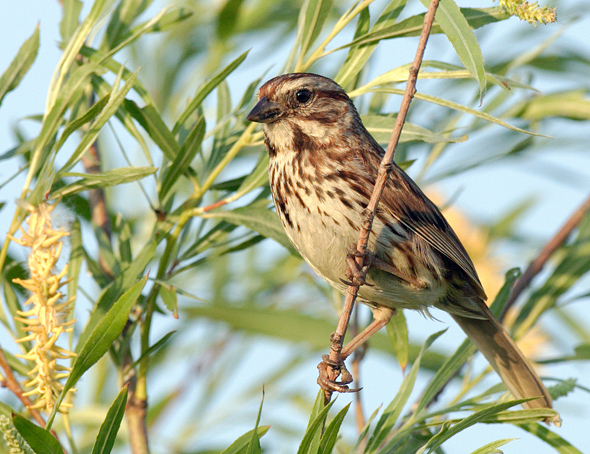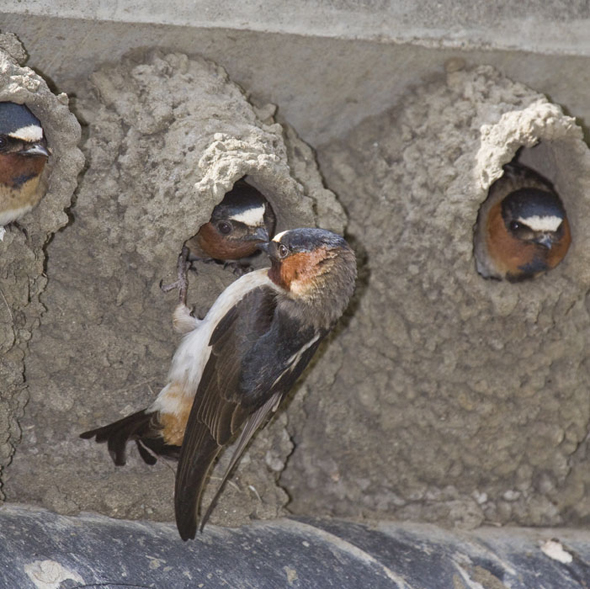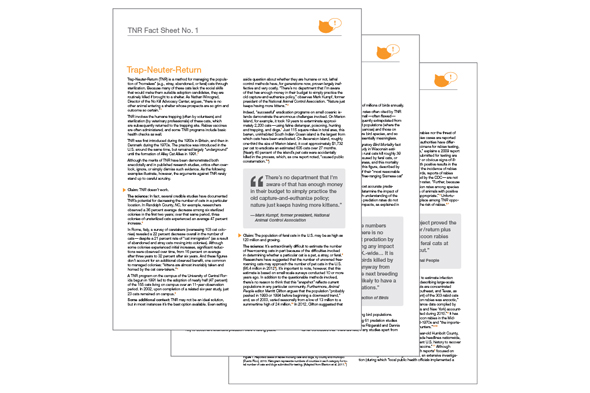
Song Sparrow, Whitby, Ontario. Photo courtesy Wikimedia Commons and Mdf.

New study attempts to demonstrate how the presence of predators alone can reduce songbird reproduction by bombarding birds with round-the-clock audio recordings of predator noises. One co-author of the study goes further, attempting to implicate cats.

The purpose of scientific inquiry (am I wrong about this?) is to reveal some truth about our world. Or the universe, in the case of astrophysics, say. Or, if we want to zoom out (and in, simultaneously) further still, the multiverse. Regardless of the particular phenomena under investigation, it’s essential that the methods employed replicate—to the extent possible—real-world conditions as closely as possible.
Easier said than done—especially when the work is set in the messy, often uncooperative, real world, where researchers struggle to balance the desire for laboratory-like control (necessary for valid analysis) with the vérité-like need for authenticity (necessary for valid conclusions). Or not, as a study published last week in Science demonstrates.
According to a story on the publication’s website, the research “shows that the mere sound of predators reduces both the number and survival rate of songbird offspring, regardless of the true threat.”
In fact, the songbirds in question were subject—Waco- or Guantánamo-style—to a round-the-clock barrage of menacing sounds over the entire four-month breeding season. Little wonder, then, their productivity was affected; what’s surprising is that these birds and their offspring survived at all (and didn’t decamp to quieter—even inviting (more on that shortly) terrain nearby).
What’s this got to do with cats? As Michael Clinchy, Adjunct Assistant Professor in the University of Victoria’s Department of Biology, and co-author of the study, explains in the ScienceNOW story, “our results show that the mere presence of this introduced predator is enough to negatively impact native wildlife.”
Perhaps Clinchy was expecting readers to overlook the bizarre methods he and his colleagues used. Or read their paper, “Perceived Predation Risk Reduces the Number of Offspring Songbirds Produce per Year” (PDF), in which there is no mention of cats at all.
But for those of us who are paying attention, it’s clear: Clinchy is simply in no position to comment on the possible impact of cats—or, for that matter, any predator that doesn’t routinely participate, together with a host of other predators, both avian and mammalian, in a maniacal chorus incessantly tormenting the song sparrows breeding on British Columbia’s Gulf Islands (culminating, by the way, in no physical attack—which, no doubt, only further unsettles and disorients the targeted birds).
The Study
Joining Clinchy in the research was frequent collaborator Liana Zanette, Associate Professor in the University of Western Ontario’s Department of Biology (lead author of the paper), along with Aija F. White and Marek C. Allen, both of UWO. The objective, they explain, “was to test whether perceived predation risk per se affected offspring production.” [1]
To do so, the researchers exposed song sparrows on five of BC’s Gulf Islands to “playlists” of various “calls and sounds” either of predators known to frequent the area, or of the area’s non-predators. Among the predators were the common raven, northwestern crow, Cooper’s hawk, brown-headed cowbird, raccoon, and three species of owls. (The closest we get to a cat is a “brush disturbance sound.”) Non-predators included the Canada goose, mallard duck, northern flicker, Rufous hummingbird, belted kingfisher, downy woodpecker, common loon, harbor seal, and two species of frog (along with “surf sound,” a benign match to the aforementioned brush disturbance sound).
“To compose our playlist of non-predator calls and sounds,” write Zanette et al., “we:
“(i) excluded any associated with either obvious competitors (other songbirds), or potential food sources (invertebrates, e.g. crickets chirping); (ii) included only calls and sounds known to be heard at our study locations; (iii) matched our diurnal predator list with a diurnal non-predator list, and our nocturnal predator list with a nocturnal non-predator list; and then (iv) matched each predator with a non-predator call or sound that had acoustic properties that were as similar as possible.” [1]
Twelve nesting females were exposed to the predator playlist; while 12 others, located nearby, were exposed to the non-predator playlist. “Playbacks were broadcast every few minutes, 24 hours per day on a 4-day-on-4-day-off cycle, throughout the 130-day breeding season.” [2] (Average daytime interval: 2 minutes 20 seconds of playback followed by 3 minutes 30 seconds of silence; average nighttime interval: 2 minutes 20 seconds/5 minutes 22 seconds. [1])
Nest predation was prevented by “protecting every nest in the experiment with both electric fencing and seine netting.” [2]
To evaluate the effect of the predator playback broadcasts, the researchers compared several metrics between the two groups of sparrows. Among them:
“the number of offspring produced per year… egg and brood mass, nestling susceptibility to thermoregulatory stress (skin temperature 10 min after mother flushed from nest), and four measures of behavior reflective of effects on habitat use: nest site selection, vigilance (flight initiation distance, i.e., distance of experimenter from nest when mother flushed from nest), nest attendance (incubation bout duration), and foraging (parental feeding visits per hour during brood-rearing).” [2]
(Note: A detailed description of the methods and analysis employed, as well as photos of the site and equipment used, can be found in the paper’s “Supporting Online Material” (PDF))
The data show that predator-playback females produced, on average, few eggs, nestlings, and fledglings than their non-predator-playback counterparts, for a 40 percent reduction in offspring overall. In addition:
“predator-playback females built their nests in denser, thornier vegetation, were more skittish… and spent shorter times on and longer times off the nest during incubation, and predator-playback parents made fewer feeding visits per hour during brood-rearing. Effects on all four behaviors were associated with effects on offspring number and condition.” [2]
The Researchers
Zanette and Clinchy have been studying the Gulf Island’s song sparrows for 12 years or more now, their work focused largely on the demographic impacts of predatory pressures and food supply (as well as the interaction of the two: “We conclude that annual reproductive success in song sparrows is a function of both food-restricted production and predator-induced loss and indirect food and predator effects on both clutch and brood loss.” [3]). Predation by cats plays only a minor role in their published work, yet both Zanette and Clinchy seem quite eager to talk up that role for more mainstream audiences.
In an interview on CBC’s The Current about her participation in the documentary Cat Crazed, for example, Zanette describes research in which she and Clinchy used video cameras to “capture predators in the act of preying upon songbird nests” in Rithet’s Bog, 10–15 miles south the Gulf Islands.
“What we’ve found over the years is that, of all predation events that we recorded, cats are responsible for 22 percent of those. OK, so that’s cats going in and taking songbird eggs, and chewing on songbird nestlings—completely wiping out the reproductive effort of those parent birds… They chomp, and sometimes they look at the camera and they lick their lips afterwards.”
Although Zanette does acknowledge some other culprits—rats and brown-headed cowbirds, mostly—it’s with far less enthusiasm. Granted, the interview wasn’t about rats or cowbirds, but the context doesn’t explain the outsized impact Zanette ascribes the bog’s cats.
Clinchy’s also interviewed for the film—which, I need to point out, I’ve yet to see, as it’s unavailable for online streaming outside of Canada (and, for reasons that will become clear momentarily, I refuse to purchase the DVD). However, in a story appearing in the online version of Vancouver’s Georgia Straight, which the publication describes as “Canada’s largest urban weekly,” Judith Webster (author of the highly recommended 2007 paper “Missing Cats, Stray Coyotes: One Citizen’s Perspective”) notes: “it’s clear Clinchy was directed by the Cat Crazed interviewer to focus on his lack of fondness for cats.”
And then there’s his comment last week about “this introduced predator.” All in all, it’s difficult to take these two seriously when they start talking about the impact of cats on the song sparrows they study.
(None of which explains, however, why I haven’t bought the Cat Crazed DVD. That’s because of my dislike for the film’s director, Maureen Palmer, who, in addition to the obvious bias she brought to Cat Crazed, apparently lied to the Toronto Star about the conditions of the cats treated by FixNation, a top-notch high-volume spay-neuter clinic north of Los Angeles. I’d hate to see even a dime of my money—10.2 cents Canadian—used to support her agenda.)
The Sparrows
“Our results suggest that the perception of predation risk is itself powerful enough to affect wildlife population dynamics,” write Zanette et al., “and should thus be given greater consideration in vertebrate conservation and management.” [2] Even setting aside for the moment the unrealistic methods employed, the fact that these sparrows produced 40 percent fewer offspring doesn’t necessarily demonstrate population-level impacts; a single breeding season’s observations are hardly sufficient to make such projections.
And, more to the point, the authors don’t actually mention anything about the population dynamics of song sparrows in the real world. The Song Sparrow is, according to the Cornell Lab of Ornithology website, a species of Least Concern. That said, Breeding Bird Survey data indicate a 0.6 percent annual decrease, on average, from 1966 through 2009. (Among the most credible BBS data, the steepest decline, 2.1 percent, was seen in Alberta, while the greatest annual increase, 5.0 percent, comes from Missouri.)
So, is the decline suggested by BBS data the result of song sparrows subject to the “calls and sounds” of cats (or any number of “brush disturbance sounds”)? I suspect it has much more to do with the calls and sounds of humans—whose numbers in the U.S. soared 55 percent, from 197 to 307 million, between 1966 and 2009.
In fact, the interaction of cats and song sparrows has been studied in some detail when Cole Hawkins conducted his PhD work during the mid-1990s in two Alameda County, CA, parks. As I’ve mentioned previously, Hawkins’ conclusions are largely indefensible, but I take him at his word when it comes to his bird counts. And song sparrows were among five (of nine total) ground-feeding species that demonstrated “no clear preference for the no-cat or cat area [where up to 26 cats were being fed regularly].” [4] (In fact, in nine of the 14 surveys conducted over the course of Hawkins’ research, the number of song sparrows seen in the cat area exceeded the number seen in the no-cat area—in some cases by a factor of two or three.)
Yet, for all Zanette and Clinchy’s apparent concern for cats predating song sparrows, they never once cite Hawkins’ work.
The Take-away
I’ve no doubt that this study was, as the researchers themselves describe it, “logistically very challenging.” [1] Managing the technology involved (which doesn’t always cooperate in the field) and the constant monitoring of nests and nestlings would, alone, keep a team of bright, ambitious researchers on their toes. But hard work, in and of itself, does not necessarily produce meaningful results.
As Julie Levy, Maddie’s Professor of Shelter Medicine in the University of Florida’s College of Veterinary Medicine, mentioned in a comment on the ScienceNOW website, the study would have benefited from a “baseline control group” not subjected to the same “high degree of investigator interference.”
Levy goes on to speculate (admitting “it may be far-fetched”) that the non-predator-playback sparrows may have been “so relaxed and comfortable that their fledgling rate increased by 40 percent.”
Maybe it’s not so far-fetched.
Australian National University biologists Tonya Haff and Robert Magrath, whose work is cited by Zanette et al., argue that nestlings are “finely tuned to their acoustic world, and responded appropriately to sounds of danger nearby.” [5] So why couldn’t adult birds pick up on cues—broadcast continuously every 96 hours—suggesting that (1) there is no danger, and (2) food supplies are plentiful?
The predator-playback group, by contrast, would be picking up cues unlike anything they’d ever experienced: round-the-clock danger, in the air and on the ground.
One wonders, too, what impact a single-predator playback—say, Cooper’s hawks—might have had, used in intervals that mimic real-world conditions. Although Zanette et al. “have yet to observe them attacking a nest, they have been recorded doing so elsewhere and are known to represent a significant threat to adult sparrows.” [1] And, as Zanette and Clinchy point out in a previous paper, their research site has “the highest density of Cooper’s hawks in Canada.” [6]
In fact, Zanette et al. have already set the stage for such investigations—and funding: “it will be fruitful to evaluate the effects of cues from specific predators in future studies.” [1]
The Reaction
Not surprisingly, “Perceived Predation Risk” made UWO’s homepage, the proud university overstating the (already-overstated) implications of the work (even the authors must wince at the word prove): “New findings from Western prove fear of predation risk is powerful enough to affect wildlife populations even when predators are prevented from directly killing any prey.”
And it took The Wildlife Society’s Michael Hutchins less than 24 hours to endorse the paper, calling it “devastating to feral cat TNR advocates.” Misquoting Clinchy, Hutchins goes on to say the paper “is just another example of the growing peer-reviewed literature on this topic, which are providing strong evidence for the negative impact of feral cats on our native wildlife.” Demonstrating once again (as if we needed any more evidence) his commitment not to sound science, but to any headline that might drum up support for his witch-hunt (and year-end donations). (My comment, by the way, is awaiting approval.)
• • •
In the end, I’m left to wonder how studies such as this one—with its deeply flawed design—receive funding in the first place (in this case, by the Natural Sciences and Engineering Research Council of Canada and the Canada Foundation for Innovation and the Natural Sciences) and then warrant publication in Science (“the world’s leading outlet for scientific news, commentary, and cutting-edge research”).
Instead of increasing our understanding of the world, this research only adds to our misunderstanding.
I attempted to contact both Zanette and Clinchy by e-mail on Friday, but have yet to receive a reply (though there have been multiple visits to the Vox Felina site from in and around London, Ontario, where Zanette is based). Zanette never replied to my previous inquiry, either, related to her comments in the CBC interview.
Literature Cited
1. Zanette, L.Y., et al., “Perceived Predation Risk Reduces the Number of Offspring Songbirds Produce per Year (Supporting Online Material).” Science. 2011. 334(1398). http://www.sciencemag.org/content/suppl/2011/12/08/334.6061.1398.DC1/Zanette.SOM.pdf
2. Zanette, L.Y., et al., “Perceived Predation Risk Reduces the Number of Offspring Songbirds Produce per Year.” Science. 2011. 334(6061): p. 1398–1401. http://www.sciencemag.org/content/334/6061/1398.abstract
3. Zanette, L., Clinchy, M., and Smith, J.N.M., “Combined food and predator effects on songbird nest survival and annual reproductive success: results from a bi-factorial experiment.” Oecologia. 2006. 147: p. 632–640.
4. Hawkins, C.C., Impact of a subsidized exotic predator on native biota: Effect of house cats (Felis catus) on California birds and rodents. 1998, Texas A&M University.
5. Haff, T.M. and Magrath, R.D., “Vulnerable but not helpless: Nestlings are fine-tuned to cues of approaching danger.” Animal Behaviour. 2010. 79(2): p. 487–496. http://www.sciencedirect.com/science/article/pii/S0003347209005417
6. Zanette, L., et al., “Synergistic effects of food and predators on annual reproductive success in song sparrows.” Proceedings of The Royal Society B. 2003. 270: p. 799–803.



